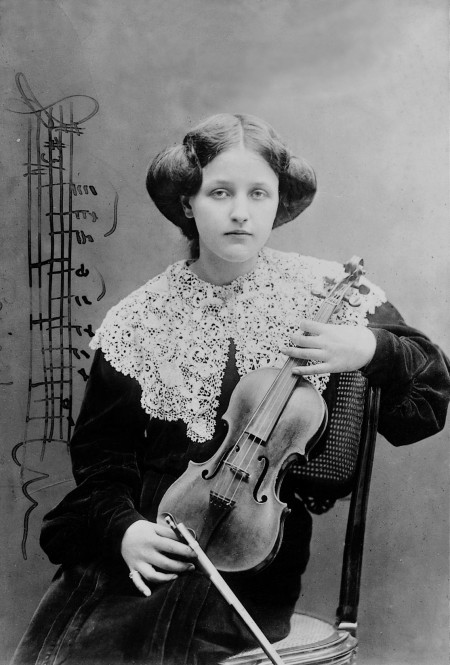28 January 1888, Budapest – 11 December 1956, Zürich
Stefi Geyer received her first violin lessons from her father who was a doctor and an amateur violinist. Her official musical training began at the age of seven, when she became a student of Kálmán Adolf, teacher of the Nemzeti Zenede (Music Secondary School). Her fast development was proven by her public performances a few months later and that she was admitted to the Academy of Music in few years time, where she was a student of the world-famous violinist and outstanding pedagogue, Jenő Hubay for four years between 1898 and 1902. Her lifelong unbroken career on the stage began those years. At the age of eleven or twelve she attracted attention with her first public recitals in major cities of Hungary as well as in Vienna. Following her debut at home she toured Europe and America as a child prodigy. One of her first critics wrote: ‘Her playing was so calm, nice and artistic if she would have been playing for twenty years.[...] She has an amazing sense for interpretation, her technique is wonderful already and her using of the bow is elegant and correct.' At the same time another admirer of her predicted the following: ‘If the wonderful art of this little girl develops this way she will not need the weapon of her beautiful eyes, the voice of her violin will enslave men.'
That prophecy came true soon. Béla Bartók, whom she met at a concert at the Academy of Music in 1902, fell in an honest but unrequited love for Stefi Geyer a few years later. The memory of this relationship - ended painfully for Bartók - is preserved by letters written by the composer for Stefi in 1907 and by the Violin Concerto No.1(1907-1908), the Leitmotif of which (C-sharp, E, G-sharp, B-sharp) characterize the inspiring muse of the composition. The work could be made public only after the death of the artist.
Stefi Geyer was a sought after star of the concert venues at the end of the first decade of the 1900s, not as a child prodigy at that time but as a mature artist already. At one of her tours abroad in 1908 she met a young Swiss composer, Othmar Schoeck who was –like Bartók- captivated by the talent, personality, and beauty of the violinist. The composer's love for Stefi evolved at a tour in 1908 in Switzerland, where Schoeck acted as her chamber music partner. The Violin Sonata Op. 16was composed the same year with a dedication to Stefi Geyer, of course. His love remained unrequited, too. This refusal did not inhibit the composer in dedicating his Violin Concerto Op. 21, written with a romantic impetus – inspired probably partially by the storms of his private life - in 1911-1912 also to the artist.
She lived in Vienna at that time already. She settled there in 1911 and remained in the city with great musical traditions until 1919. Probably she met Alban Berg at that period with whom they were friends for decades. There she became acquainted with Walter Schulthess, Swiss pianist and composer, her later husband. They moved to Zürich together in 1919 and got married the following year already. Schultess composed his Concertino Op.7 for her in 1921. She performed that in Budapest in April 1922, with György Kósa and took part in a longer tour in America in 1924 that was accompanied by laudatory criticisms by the press there.
She played a significant role in Swiss musical life as an internationally renowned artist. From 1923 to 1953 she led her master school at the Conservatory of Zürich with extraordinary pedagogical talent. In 1941 she founded the Collegium Musicum with her husband in Zürich led by Paul Sacher, of which she was the soloist and first violinist. Besides that she played chamber music concerts with her husband and former admirer and friend, Schoeck. One of the most outstanding phases of her career was that decade between 1943 and 1953, when she gave unforgettable all-Beethoven recitals with Wilhelm Backhaus. Her devotion for music is characterized by the fact that having an international artistic and pedagogical career she did not find it morganatic to play with her students at quartet concerts and to play in the first violin section in the orchestra of the International Festive Weeks in Luzern that was held yearly from 1938. This latter activity could have been rather a present than a duty for her as the orchestra was conducted by the most outstanding conductors, among others: Arturo Toscanini, Ernest Ansermet, Rafael Kubelik and Wilhelm Furtwängler.
Stefi Geyer owned an extraordinarily broad repertoire. Besides the great classics of the violin literature she was an expert interpreter of modern works, as well. From the violin concertos dedicated to her she premiered the one of Schoeck and the Violin Concerto No.2 Op. 69 of Willy Burkhard, composed in 1943.
She died on December 11th in 1956 in Zürich.
P. Cs.



